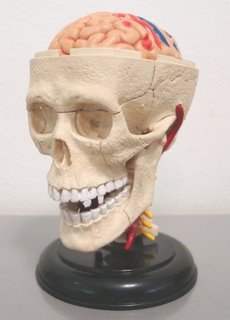 At this time of the year, most big media companies will publish some sort of "Top Ten" articles that review the news highlights of the outgoing year.
At this time of the year, most big media companies will publish some sort of "Top Ten" articles that review the news highlights of the outgoing year.Some of these lists are mindnumbingly long. Top 50 newsworthy events? Top 100?
Prioritize, people.
And even worse, all of them seem to include Britney Spears or Paris Hilton, as if they need any more publicity.
Scandal is fun the first time 'round - but after the 5000th time, it just gives you a pukey feeling.
Here at Fresh Brainz, we loathe to follow other people's pointless traditions, preferring to invent our own pointless traditions.
We initially planned an exclusive New Year's party in a downtown club for insiders and diehard fans that would feature free-flowing chocolate and a special dance by a sexy model wearing nothing but fresh waffles.
Unfortunately our limited budget (which currently stands at a grand total of $10.66) does not permit the establishment of this tasteful new tradition.
Hence it is with drenched spirits that we present to you: the Top 3 Science News in 2007!
1. Dinosaurs Are Finger Licking Good
In April this year, two teams of scientists managed to isolate a section of a protein (collagen) from a 68 million-year-old fossil of Tyrannosaurus rex. Mass spectrometry revealed that the protein sequence resembles that of the modern chicken, providing more experimental support of the evolutionary kinship between dinosaurs and birds.
This is simply the No. 1 most impressive scientific discovery of the year. Of course it would be even better if they got a recognizable stretch of T. Rex DNA (though DNA tends to break down into many tiny fragments over millions of years which is very difficult to re-assemble. Contamination is also a big problem).
Nonetheless it is an important proof-of-principle study on a very old specimen. As the technique becomes more refined, we will be able to study fossils using molecular biology. For more recently extinct animals such as mammoths and Neandertals, we will be able to re-assemble a significant section of their DNA in the coming few years.
In conjunction with other advances in molecular genetics and developmental biology, perhaps one day we will be able to resurrect an extinct species back to life.
2. Every Skin Cell Is Sacred
Some people would say "but studying dinosaurs doesn't help cure cancer!"
Well, this next technological advancement probably won't help cure cancer either, but it is in the biomedical field (which most non-scientists pretend to care about) and has the potential to treat many diseases.
Last month, two teams of researchers announced their success in engineering induced pluripotent cells (iPS) using adult tissues, such as skin cells, as the starting material. This new cell type exhibits many characteristics of human embryonic stem cells, and gets around the ethical objection of religious groups to the destruction of human blastocysts.
The amazing thing is that the reprogramming procedure only involves four genes. While other groups were busy discovering more and more genes involved in pluripotency, these scientists were already applying their biological knowledge into practice, demonstrating their strategic foresight.
A major drawback of their current technique is the potential to cause tumours. To address this, one of the teams found a way to drop one of the four genes, called c-Myc, which promotes tumour growth. This improvement came hot on the heels of the original announcement.
Due to the medical significance of this advancement, key members of both research teams are likely to win Nobel Prizes within the next decade or so. The field is heating up, so look out for more exciting developments coming your way.
3. Rockin' Dust
Way back in 1971, an unknown graduate student toiled away on his PhD thesis, focusing on interplanetary dust. He spent numerous solitary nights under the stars while operating a big telescope in the Canary Islands.
In addition, he was jammin' on the side, a guitarist in a rock group that eventually becomes an international sensation. He gave up his academic work to pursue a career in music.
That lucky young man turned into a multi-millionaire superstar: Brian May, the founder of Queen.
He finally submitted his thesis in August - if it is approved he will be receiving his PhD in May 2008, a whopping 37 years after starting grad school.
The quintessential fantasy of every graduate student, Brian May's story is a prime source of inspiration and insane jealousy. Who doesn't want to have her cake and eat it too?
As such, this not-very-sciencey news makes it into the Top 3.
Because we know that science geeks are in the business because they love science.
Not because they hate sex, drums or Rock 'n Roll.
**********
So there it is, the Top 3 science news of 2007.
Thanks for reading, bye.
See you next year.
I said bye-bye.
Sayonara.
Wha... You're still here?
You have a "waffle girl" on your mind?

Heh.
Have a happy and healthy New Year 2008!
 It is with great pleasure that Fresh Brainz brings to you our
It is with great pleasure that Fresh Brainz brings to you our 









 The juiciest posts from the science 'o sphere!
The juiciest posts from the science 'o sphere!
 Psychiatrist
Psychiatrist 
 A few weeks ago, I attended a studio model photography session. I've recently had my portfolio appraised by professionals, and while they agree that many of my photos are quite good, they are not impressed with my portrait shots.
A few weeks ago, I attended a studio model photography session. I've recently had my portfolio appraised by professionals, and while they agree that many of my photos are quite good, they are not impressed with my portrait shots.















 Sometimes, we are so obsessed in our quest to find out all the answers in life that we neglect to examine the questions. This is
Sometimes, we are so obsessed in our quest to find out all the answers in life that we neglect to examine the questions. This is 

 Your humble narrator is down with the ol' aches and pains, sore throat and persistent cough. Regularly scheduled programme will be back soon. Stay tuned!
Your humble narrator is down with the ol' aches and pains, sore throat and persistent cough. Regularly scheduled programme will be back soon. Stay tuned!







